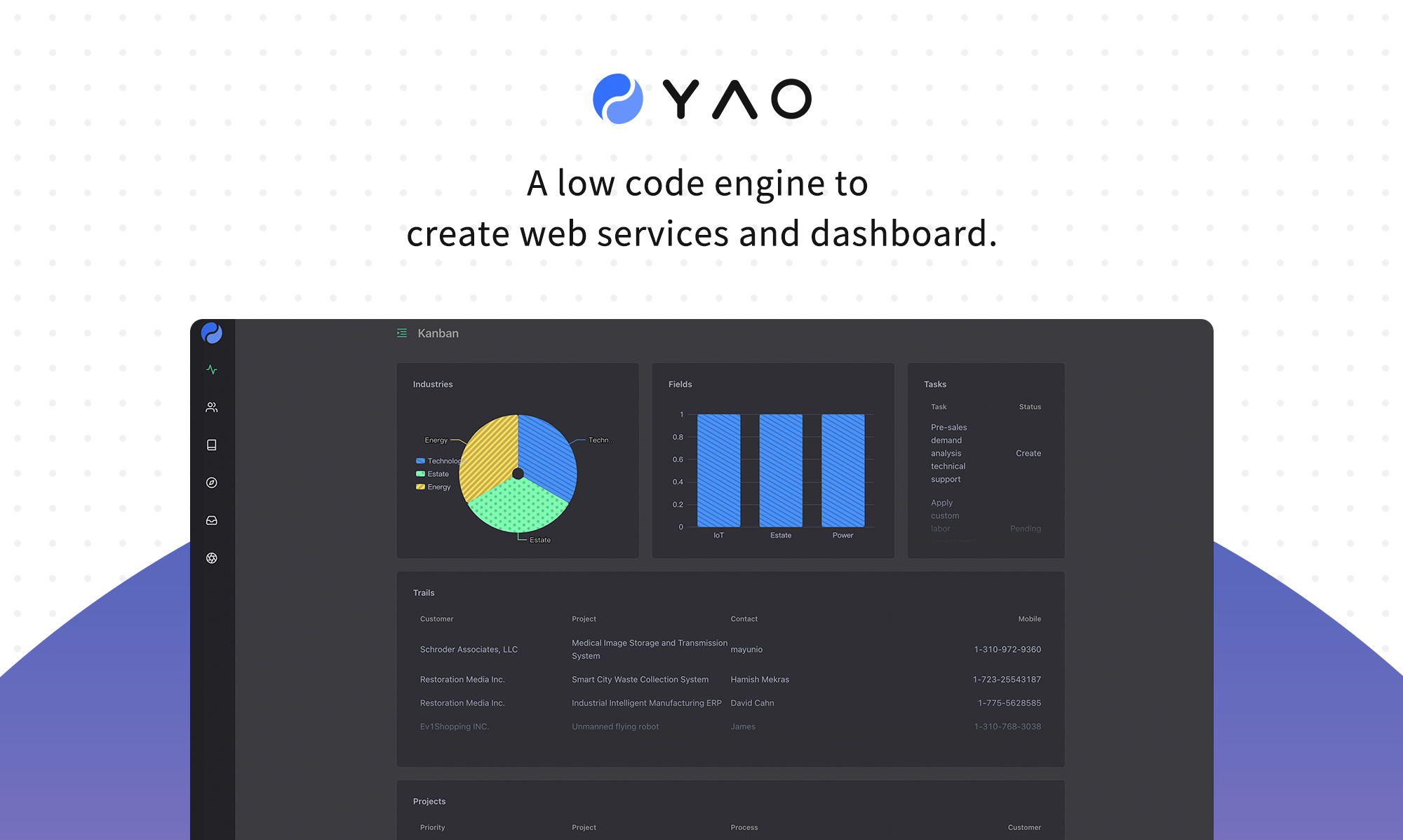
A performance app engine to create web services and applications in minutes.Suitable for AI, IoT, Industrial Internet, Connected Vehicles, DevOps, Energy, Finance and many other use-cases.
Demos
Customer Relationship Management System
A Customer Relationship Management System developed by Yao.
Intelligent warehouse management system
An example of cloud + edge IoT application, an unattended intelligent warehouse management system that supports face recognition and RFID.

Golang based, Low-Code Demo Application
Introduction
Yao allows developers to create web services by processes. Yao is a low-code engine that creates a database model, writes API services, and describes a dashboard interface just by JSON for web & hardware, no code, and 10x productivity.
Yao is based on the flow-based programming idea, developed in the Go language, and supports multiple ways to expand the data stream processor. This makes Yao extremely versatile, which can replace programming languages in most scenarios, and is 10 times more efficient than traditional programming languages in terms of reusability and coding efficiency; application performance and resource ratio Better than PHP, JAVA and other languages.
Yao has a built-in data management system. By writing JSON to describe the interface layout, 90% of the common interface interaction functions can be realized. It is especially suitable for quickly making various management backgrounds, CRM, ERP, and other internal enterprise systems. Special interactive functions can also be implemented by writing extension components or HTML pages. The built-in management system is not coupled with Yao, and any front-end technologies such as VUE and React can be used to implement the management interface.
Install
Run the script under terminal: (MacOS/Linux)
curl -fsSL https://website.yaoapps.com/install.sh | bash
For Windows users, please refer to the Installation and Debugging chapter: Installation and debugging
Getting Started
Step 1: Create a golang-based project
Create a new project directory, enter the project directory, and run the yao init command to create a blank Yao application.
mkdir -p /data/crm # create project directory cd /data/crm # Enter the project directory yao init # run the initializer
After the command runs successfully, the app.json file , db, ui , data and other directories will be created
├── data # Used to store files generated by the application, such as pictures, PDFs, etc. ├── db # Used to store SQLite database files │ └── yao.db └── ui # The static file server file directory, where custom front-end products can be placed. The files in this directory can be accessed through http://host:port/filename . └── app.json # Application configuration file, used to define the application name, etc.
Step 2: Create the data table
Use the yao migrate command to create the data table, open the command line terminal, run in the project root directory:
yao migrate
initialization menu
yao run flows.setmenu
Step 3: Start the Golang service
Open a command line terminal, run in the project root directory:
yao start
- Open a browser, visit
https://127.0.0.1:5099/xiang/login/admin, - Enter the default username:
[email protected], password:A123456p+
About Yao
Yao’s name is derived from the Chinese character yao (yáo), the primary symbol that makes up the Eight Trigrams. The Eight Trigrams is a symbol system created by the ancient god Fuxi after observing and summarizing the laws of nature, which can refer to everything. Yao has two states of yin and yang, like 0 and 1. The transformation of yin and yang of Yao drives the replacement of Eight Trigrams, so as to summarize and record the development law of things.

